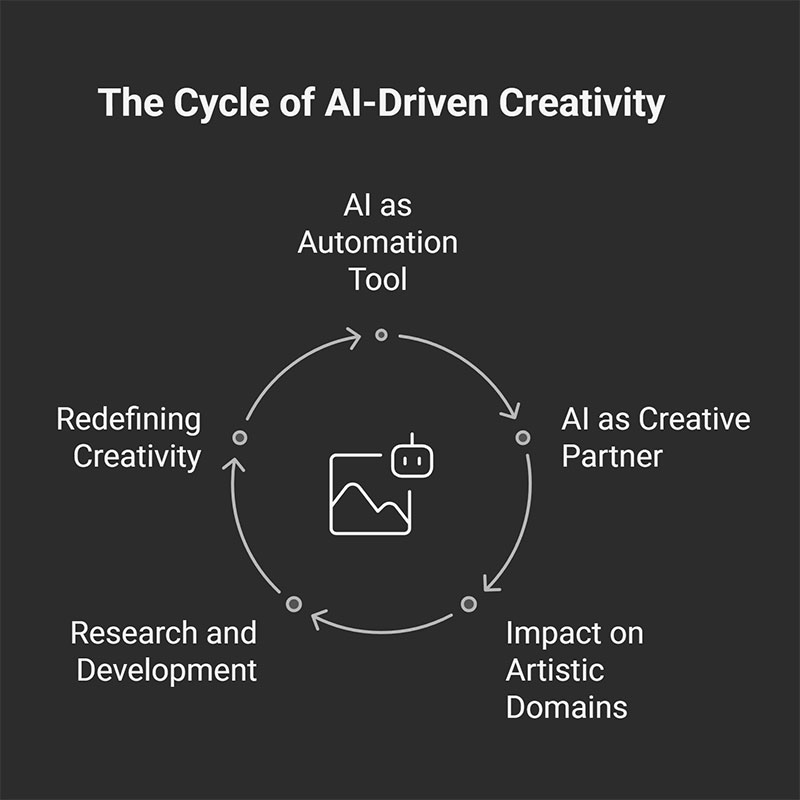AI’s creative evolution continues to redefine the boundaries of creativity, pushing the limits of what machines can achieve in artistic and innovative domains. Recent developments highlight a fascinating shift as AI ventures into new and unexpected creative directions. This evolution expands the scope of AI applications and sparks a dialogue about the future of human-machine collaboration in the arts and beyond [1].
The Rise of AI in Creative Industries
Over the past few years, AI has transitioned from simple automation tools to powerful creative partners. AI’s role in creative processes has grown exponentially from generating music and artwork to assisting in storytelling. As technology advances, researchers and developers are exploring four groundbreaking directions that promise to reshape the landscape of AI-driven creativity [1,4].

1. AI as a Co-Creator in Fine Arts
Expanding Artistic Boundaries
One of the most exciting developments is AI’s emergence as a co-creator in fine arts. Artists are leveraging AI algorithms to generate unique visual pieces, often collaborating with machines to explore new styles and techniques. This partnership allows for unprecedented experimentation, blending human intuition with machine precision. Forbes highlights how AI is being used to simulate complex textures, analyze vast art histories, and enable artists to create hybrid artworks that challenge traditional notions of authorship [1].
- AI tools analyze vast art histories to inspire new creations [1].
- Artists use AI to simulate complex textures and color schemes [1].
- Collaborative projects result in hybrid artworks that challenge traditional notions of authorship [1].
2. AI-Driven Narrative and Storytelling
Crafting Immersive Experiences
AI’s capabilities in natural language processing are transforming storytelling. Rather than merely generating text, AI now helps craft interactive narratives that adapt to user choices, creating personalized storytelling experiences. Forbes notes that dynamic systems in gaming and narrative design are using AI to map cognitive science with game design, resulting in more engaging and responsive stories [1].
- Dynamic storylines that evolve based on reader or player input [1].
- AI-generated characters with realistic dialogue and personalities [1].
- Integration of AI into video games and virtual reality for immersive adventures [1].
3. Synthetic Media and Deep Creativity
Pioneering New Media Forms
The advent of synthetic media—such as deepfakes, AI-generated music, and virtual influencers—marks a new era of digital creativity. These technologies enable the creation of hyper-realistic content that blurs the line between reality and imagination. Forbes discusses how these advances allow creators to produce content rapidly and at scale, while also raising ethical questions about authenticity and manipulation [1,4].
- Artists and creators can produce content rapidly and at scale [1].
- Raises ethical questions about authenticity and manipulation [1].
- Encourages innovative storytelling that leverages synthetic media’s versatility [1].
4. AI as a Catalyst for Cultural and Social Innovation
Promoting Diversity and Inclusion
AI is increasingly being used to highlight diverse cultural narratives and amplify marginalized voices. By analyzing vast datasets, AI can identify underrepresented stories and suggest new avenues for cultural expression. According to Forbes, this approach fosters the development of culturally sensitive art and media, facilitating cross-cultural collaborations, and supporting social movements through creative campaigns powered by AI [1].
- Developing culturally sensitive art and media1.
- Facilitating cross-cultural collaborations1.
- Supporting social movements through creative campaigns powered by AI1.
Embracing the Future of AI in Creativity
The evolving landscape of AI-driven creativity presents exciting opportunities for artists, technologists, and audiences alike. As these unexpected directions unfold, they challenge us to rethink what it means to create and experience art. Forbes and leading AI researchers emphasize that AI is no longer just a tool but an active partner in creative pursuits, with the next wave of innovation promising more personalized, inclusive, and boundary-pushing creative outputs [1,5].
“AI may have kind of the same effect [as the printing press] but the next step… it’s going to be a new Renaissance perhaps for humanity.” — Yann LeCun, Chief AI Scientist at Meta5
As the years or even months pass by, AI’s creative evolution will continue to unravel new possibilities.
References:
1 Forbes: 4 New Creative Directions For AI
4 RamaOnHealthcare: 4 New Creative Directions For AI
5 Yann LeCun & John Werner on The Next AI Revolution – YouTube


